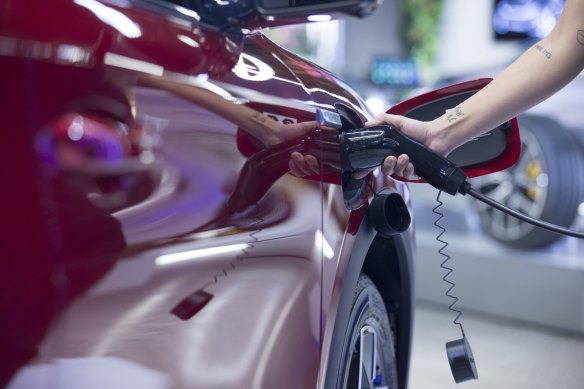By Mike Foley and Nick Toscano
Electric cars could soon be sending power to the grid to stop blackouts, or earning customers payments for discharging their batteries, with a major new reform program under way to ready the electricity market for the clean energy shift.
State and federal energy ministers met in Melbourne of Friday to finalise agreement over the reforms, which are also focused on consumer protections aimed at lowering power bills and have been referred by governments to the grid’s official rule maker – the Australian Energy Market Commission.

Moves are under way to enable electric vehicle owners to get paid for discharging their batteries into the grid. Credit: Bloomberg
“This is the next big reform for the energy system, making sure that those consumers who have solar panels or a battery or an electric vehicle are able to get maximum benefit out of it for themselves and also for the grid,” said federal Energy Minister Chris Bowen.
Dubbed the National Consumer Energy Resources Roadmap, the reform includes a range of measures such as ensuring energy plan benefits last the length of a contract, preventing price increases for a fixed period under retail contracts, improving customers’ ability to switch to better offers and assisting hardship customers.
The package has been referred to the commission, which must consult industry and the public, and implementing the reforms could take years.
Electric vehicles are set to multiply rapidly on our roads. NSW, Victoria and Queensland have set targets for EVs to reach 50 per cent of new car sales by 2030 and 100 per cent by 2035.
Electricity retailers have previously conducted trials to take advantage of market movements, with vehicles discharging their batteries when power prices are high and charging when prices are low.
The roadmap made public on Friday confirmed an agreement to set up nationally consistent rules for electric vehicles to export power stored in their batteries back into the grid. It would also streamline rules for rooftop solar panel owners, who can already export into the grid.
As well, it could enable the power stored in vehicle batteries to save the grid from crisis.
A world-first Australian trial proved, in February this year, that electric vehicles fitted with appropriate technology at the point of charging can detect a disruption in the grid’s electricity supply and send power back into the network.
The trial, conducted by the Australian National University, was executed when Victoria’s power supply was thrown into chaos in February as toppled transmission towers at Anakie, west of Geelong, cut power to 530,000 homes.
When power supply was thrown into chaos in Victoria, 16 electric vehicles located 520 kilometres away as the crow flies, in Canberra, detected the disruption and within seconds pumped power back into the grid.
The trial tested what is known as vehicle-to-grid technology, in which devices fitted to EVs can detect small variations in the frequency of the grid that could be power supply disruptions hundreds of kilometres away.
Lead researcher on the trial Bjorn Sturmberg, who described electric vehicles as big batteries on wheels, said 105,000 of them could supply the back-up power needed for all of NSW and the ACT.
Governments are also pursuing so-called energy equity reforms to help those who cannot afford efficient appliances, solar panels and electric vehicles to benefit from savings delivered to the electricity market by new technologies.